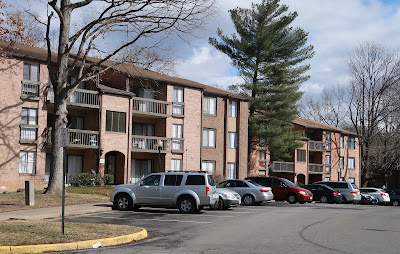County planners expected to recommend reduced requirements for off-street parking
 |
| Fairfax County planners are looking at how much parking is needed for such uses as apartments, grocery stores, office buildings, and shopping centers. |
New developments might not need as much parking as currently required in Fairfax County’s Zoning Ordinance.
That’s the idea behind the Parking Reimagined study previewed at a Mason District community meeting Nov. 18. County planners are holding similar sessions in other districts to gather feedback from residents before they draft a new zoning proposal.
The Parking Reimagined study is aimed at determining the right amount of parking for new multifamily, office, and retail projects. Planners don’t want to require too much parking that stays vacant most of the time – or too little that leads to spillover parking on residential streets.
The new zoning ordinance will only address off-street parking and loading docks for new developments, noted Mason Supervisor Penny Gross. It will not deal with on-street parking or existing off-street parking lots.
 |
| This Mason District Shopping Center might have enough parking, but the problem is getting in and out. |
Project Manager Michael Davis urged residents “to think about parking as a resource” and think about parking in relation to the environment (such as stormwater runoff), housing affordability, and land design (such as the need for green space).
Parking demand is dynamic, with demand fluctuating based on the time of day and time of year, Davis said.
Mixed-use developments could get by with shared parking, with office workers using the parking lot during the day while more residents will park there on evenings and weekends.
Trends underway before Covid, such as the rise in home deliveries and remote working, also reduce demand for parking. Those trends are expected to continue after the pandemic.
Other trends, such as the increased use of Uber, Lyft, and e-scooters, also reduce the need for parking.
The project will explore promising innovations, provide more flexibility, and streamline the parking review and approval process, Davis said.
The new zoning rules will probably set minimum parking requirements and determine how shared parking is regulated, added consultant Christopher Forinash of NelsonNygaard.
Davis suggested that areas without convenient access to Metro, such as Mason District, might have a greater need for more parking than other areas. The county has already reduced the parking requirements in Tysons, for example. The approach in Parking Reimagined is not to offer a one-size-fits-all solution, he said.
Related story: Fairfax County to revise zoning rules on parking lots
Residents of mixed-use developments with easy access to retail might need fewer cars, while younger people are more inclined to rely on ride-sharing apps, Davis said.
However, Gross noted that she hears a lot of complaints from residents of townhouse communities about inadequate parking. A household with four unrelated people might have four cars and just two parking spaces. “As we move forward, we need to remember the current situation as a cautionary tale,” she said.
The Parking Reimagined project will take 12 to 18 months. Halfway through that period, the planners will begin to draft a new zoning ordinance, which will take into account public feedback, and re-engage with the community.
In late 2022, the draft zoning ordinance will be presented to the Planning Commission and Board of Supervisors.
